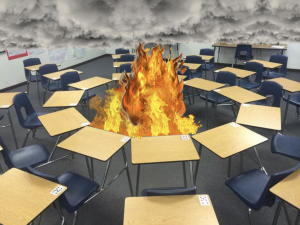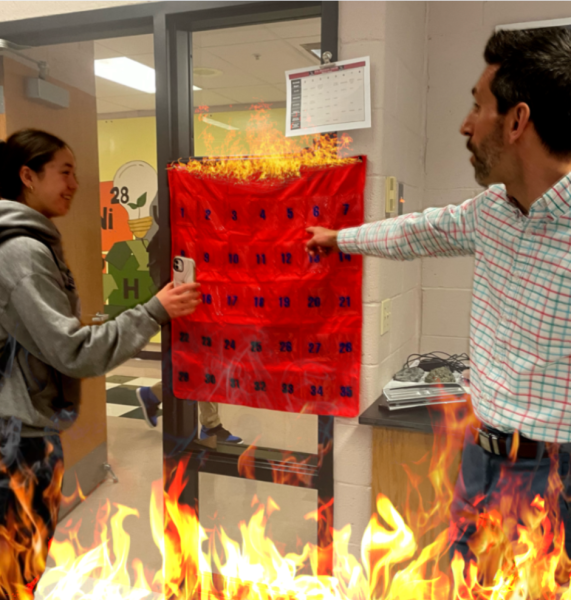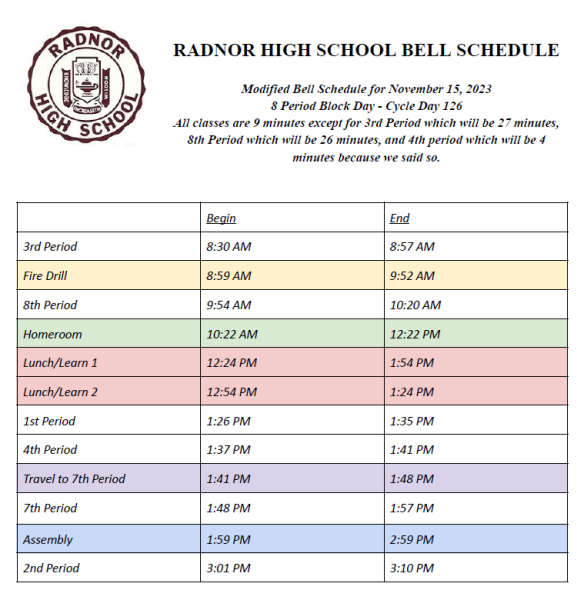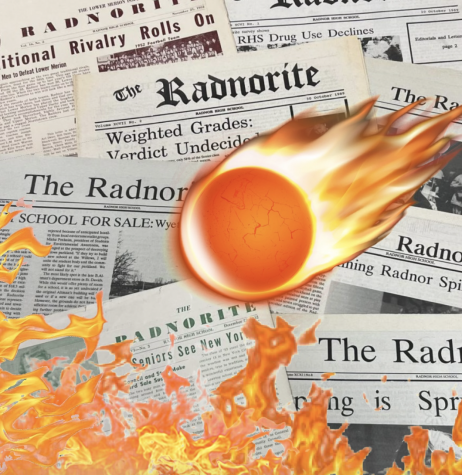“Historic”: RHS Conducts Fire ‘Drill’ Without Warning
“The Radish offers satire and parody as commentary and critique on matters of public interest. No article posted on the Radish should be taken literally or viewed as representing truthful statements of the individuals or organizations which may be mentioned in the articles.”
April 22, 2021
On Tuesday, April 6, 2021 at precisely 1:23:45 PM, Radnor High School students became the first witnesses of an unexpected fire ‘drill’ that was truly historic, unprecedented, and the first of its kind since the Big Bang in more ways than one.
The Radnor Fire Company, which offers fire alarms at $0.01 apiece and exemptively taxed at 100,006%, has explicitly stated in their Terms of Service that “All Customers attempting to conduct a drill with this Fire Alarm™ shall, in accordance to the Terms listed on this page, sound off a warning to all occupants in the secured building at least 360 seconds (six minutes) before sounding the Alarm.” This Fire Drill, however, proved to fall short of what the ToS requires.
Students were astonished that Radnor High School would ever break the cryptic Terms of Service. Indeed, during the evacuation, one freshman hastily tried to file a ToS complaint titled “Fire Drill Abuse,” seeking to report the Fire Drill for lack of warning; that freshman was stopped only by the familiar red-and-dark-grey block screen “because it is categorized as security-bypass.”
Despite this, the students evacuated as expected. While many students saw the evacuation as “not a big deal, considering we’ve done it last decade,” it was a different story for those eating lunch at that time. Even though the cafeteria had a student-to-exit door ratio of seventy to one (compared to the school average of 120:1), cafeteria evacuation was such that it nearly broke the Guinness World Record of “slowest evacuation from a building of at least 20,000 square feet.” One student lamented that “if we were still lined up to get food, we would’ve broken that record since hands-full students would create a ruckus by dropping all the food and spilling it on the floor.”
Elsewhere, students in the auditorium created an indoor Mount Everest using nothing but themselves as a result of their “evacuation.”
However, an internal post-evacuation investigation conducted at the behest of the school administration found that “the reason for the slow evacuation wasn’t the students getting food, but rather due to students chanting, ‘Stay in the cafeteria! Stay in the cafeteria!’” Such chants easily overpowered the blare of the Fire Alarm™ and convinced many students to stay in, delaying evacuation by a whopping five seconds. It was only the breaks between chants and the ever-increasing volume of the alarm and the fleeing staff members and them shouting to evacuate and the resulting de-population of the cafeteria and more alarms sounding and “Evacuate the building” being the new chant and the PA system blaring just that and the hasty cleaning up the floor of food and the resulting mess that ensued and the eventual sight of not speed-walking but running students and several students mimicking the Fire Alarm’s sound and the ruckus that followed and the mountainous but not Mount Everest pileup of students and the staff eventually coming back to get the situation under control and the eventual rapid cleanup that took place and the cleared path to the two magnificent exit doors and the remaining students failing to create another indoor Mount Everest and the staff telling them to get up and leave and the faint shouting of “Fire!” that finally made students abandon their world-record ambitions for the slowest evacuation.
One student who was in the cafeteria eventually seized some time to look up who held the Guinness World Record for the “slowest evacuation” and was beyond amazed to find out that the record went to the students in the auditorium with a time of 10:10, despite having a whopping four exit doors. On the Guinness World Records website, it stated, “RHS students accomplished this near-impossible feat by forming a pile near one of the doors and barricading the other three.”
In the meantime, the 4000 Hz tone of the red flashing speakers became the Moon landing of conspiracy theories. Some students speculate that someone deliberately pulled the Fire Alarm™ as a prank to induce panic or to arouse unnecessary suspicion from the RHS population.
“Usually when they do fire drills they’d either not use the fire alarm at all or announce it in their calendars beforehand so we all know when it happens, but having neither happen seems kinda fishy,” one student told me in an interview. Another student was convinced that the Fire Drill was but the latest attempt by the AP Psychology teacher to test the collective fight or flight or freeze response.
Indeed, fire drills are so predictable at Radnor High School that “it seems like we know when an emergency will happen before it happens,” the student added, pointing to a just-obtained leaked draft of the April calendar that says on April 6, “Fire alarms will sound at 5th period without PA warning due to water sprinkler failure.”
One student even theorized that “the security cameras all stopped working, and an intruder somehow managed to sneak into the building without being spotted by 2,824 eyes (two eyes per student and faculty member, or 706 eyes per principal), pulled the fire alarm, put on his invisibility cloak, and made a run for it.” Given that Radnor High School hasn’t done any lockdown drills in the 2020-21 school year, 95% of RHS students see this theory as the most plausible one.
Another lesser known theory spread by the remaining 5% was that the Fire Drill is a ploy to give students an unwarranted semi-mask break where students can wear their masks in “innovative” ways: uncovered noses, uncovered mouths, vertically on the head, as necklaces, as earrings, and even as jackets.
Even though the fire alarm dropped many students’ jaws, the thing that dropped students’ jaws the most and paradoxically quelled conspiracy theories was Mrs. Kevgas’ announcement on the Fire Drill. “The pressure drop in the water line triggered the water flow alarm which in turn triggered the fire alarm. The two systems are linked,” she posted on Schoology. This time, what followed were not new conspiracy theories but instead questions; so many questions that the website of the Radnor Fire Company had to shut down for a few minutes just to process all the incoming questions about the fire alarm system. All available firefighters were tasked with answering all the questions ASAP.
“Why would Radnor High School link the fire alarms to the water pressure alarms?” one user emailed to the Radnor Fire Company. “It seems a bit misleading since people would think that water starts fires.”
The Radnor Fire Company answered, “Well, you see in the Terms of Service, it also says, ‘This Fire Alarm™ shall be linked to another Alarm System unrelated to firefighting purposes.’ So we quickly ran out of options on what we should mount these alarms to. We tried hooking them up to an alarm clock, but then it would sound too often and we’d be doing too many fire drills and wasting too much electricity. That’s why the water pressure alarm.” This answer would be copied-and-pasted to 1,411 more similar questions.
However, a few theories persisted. “I almost thought we would have done reverse evacuations once I heard the Schoology announcement,” a senior said to me in class. “Many of us would’ve walked backwards, but it’s a worthwhile plan for any sprinkler antics. Plus, we’d miss the whole remainder of the fifth period and hopefully postpone a few tests.” An IdeasSurvey poll conducted in February revealed that 70% of RHS students liked the reverse evacuations, with the primary reason being attributed to “ten minutes of lost class time.”
For many RHS students, this day would live as the most oxymoronic day in human history. “This was truly historic,” a sophomore at Radnor commented. “Never before have we seen a tool that’s used to put out fires actually trigger a fire alarm. I think that thirty to forty years from now, all the engineering and history textbooks will have, ‘On April 6, 2021, a fire alarm was triggered by a water sprinkling system, showing that sometimes, human inventions can fail in the most mysterious of ways.’” A junior added, “Just look at the track record we had that day. A broken terms of service, a new world record, the first fire alarm set by water, the first fire alarm dependent on something else besides fire, and almost the second reverse evacuation since the Stone Age. I honestly can’t find a word in the English language that can describe that day.”
*Editor Note: An image of a fire alarm was used in an earlier edition of this article. The content has been removed due to copyright infringement.
















